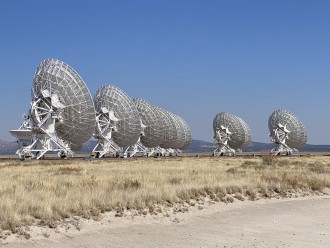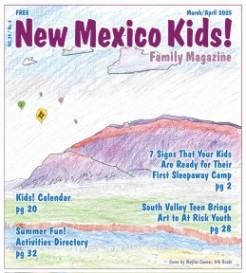The VLA Shares the Wonders of Space Exploration
The VLA Shares the Wonders of Space Exploration
January 24, 2024By Aileen O’Catherine

Like huge metal flowers pushing out of the desert floor, the 25-meter (82-foot) white satellite dishes of the Very Large Array (VLA) move across New Mexico’s Plains of San Agustin west of Socorro in configurations that capture some of the longest waves on the electromagnetic spectrum.
Radio astronomers study those large waves to look at exploding black holes, pulsating planets, dying stars and information gleaned from the beginnings of a nascent universe. Astronomer Aleksander Wolszczan used radio astronomy to tune in to the pulsar PSR B12757+12, located 2,300 light-years away, and in 1992, he and astronomer Dale Frail published a famous paper on the first exoplanets ever discovered. Exoplanets orbit stars outside our solar system.
How this work is done and who does it is at the heart of the VLA. Twice a year, the National Radio Astronomy Observatory (NRAO) invites interested visitors to an open house where they can meet the astronomers, students, data scientists and behind-the-scenes operators who turn the VLA’s data into scientific information. Everyone has the chance to visit the VLA to learn how the many stories that exist beyond Earth are captured and told. Those who can’t attend an open house can visit on their own every day of the year except for Thanksgiving, Christmas and New Year’s Day.
During a recent October open house, a group with timed entry tickets gathered at the visitor center. Our guide was none other than famed astronomer Dale Frail, who took us through the VLA’s everyday workings. He pointed out the satellite dishes, which on that day were pulled together like a tight letter Y. In this D configuration, the total telescope size is 0.64 miles across. The array of satellite dishes is called an interferometer and mimics the view of an optical telescope as big across as the farthest distance between the two furthest antennas. In the A configuration, the satellite dishes span 22.62 miles, in configuration B they span 7.08 miles, and in configuration C, 2.11 miles. The configurations equate to a degree of resolution, with the tight view of the D configuration providing a high surface brightness, but low resolution. The A configuration, on the other hand, provides high resolution but limited brightness. Scientists choose the configurations they will use to observe objects depending on their research interests.
Each satellite dish is a single tool, but when all 27 dishes collect data at the same time, the interferometer becomes an enormous radio astronomy telescope.
“If you looked at M84 in the optical (spectrum), it would be dark,” Frail told his audience as he pointed to an image of Messier object 84 (M84) enlarged as a picture on the wall behind him. Dark red swirls push out into deep black, with the center of the object looking like a huge gaping hole. Frail explained that M84 is an elliptical galaxy found in the densely populated center of the Virgo cluster of galaxies, of which there are more than 1,000.
“Optical astronomers can only see outside the nursery,” Frail said, “but as radio astronomers, we see each of the individual stars as they are blowing up, or a collection of stars being born.” He explained that in radio astronomy, scientists can see past the gas and dust, no matter the weather. With optical telescopes, the weather makes an impact, but radio astronomy operates most days out of the year. With optical astronomy, “all you would see would be a faint green blob,” Frail said. He urged the audience to look carefully at the black hole in the galaxy’s center. “Spewing out of that black hole are twin jets that you only ‘see’ in radio,” he said. “There is material going into the black hole, but material shooting out.” He pointed to the twin jets near the black hole. “They are relativistic electrons moving at the speed of light. They are going out into interstellar space and affecting all the galaxies around them, like these giant big spoons in a soup.” It was difficult not to get caught up in the excitement of understanding the image, given Frail’s enthusiasm for the subject and his deft ability to explain science. He went on to explain how the action taking place in M84 is hundreds of thousands of light-years away, and what we see is not only the past but also the future of an active galaxy.
Frail then guided us to view a giant satellite dish and explained how radio waves are turned into data with the help of equipment maintained and monitored by VLA staff. At the operations center, we learned how the interferometer is controlled via more than 2,700 miles of fiber optics that feed into the WIDAR supercomputer. WIDAR (Wideband Interferometric Digital ARchitecture) stirs through 16 quadrillion calculations a second to create data for research scientists from around the world.
The VLA offers free open houses in April and in October, with staff- and student-led tours. The visitor center features films, displays and talks held in a small auditorium, as well as a gift shop. There are self-guided outdoor walking tours for those who choose not to visit during open houses. Informative signs take visitors to the base of one of the giant satellite dishes.
The VLA is kid-friendly and a great place for a family outing.
The VLA is open to the public seven days a week, from 9 a.m. to 4 p.m. Connect with the VLA to stay tuned to upcoming open houses. To find out more, go to public.nrao.edu/visit/very-large-array.




